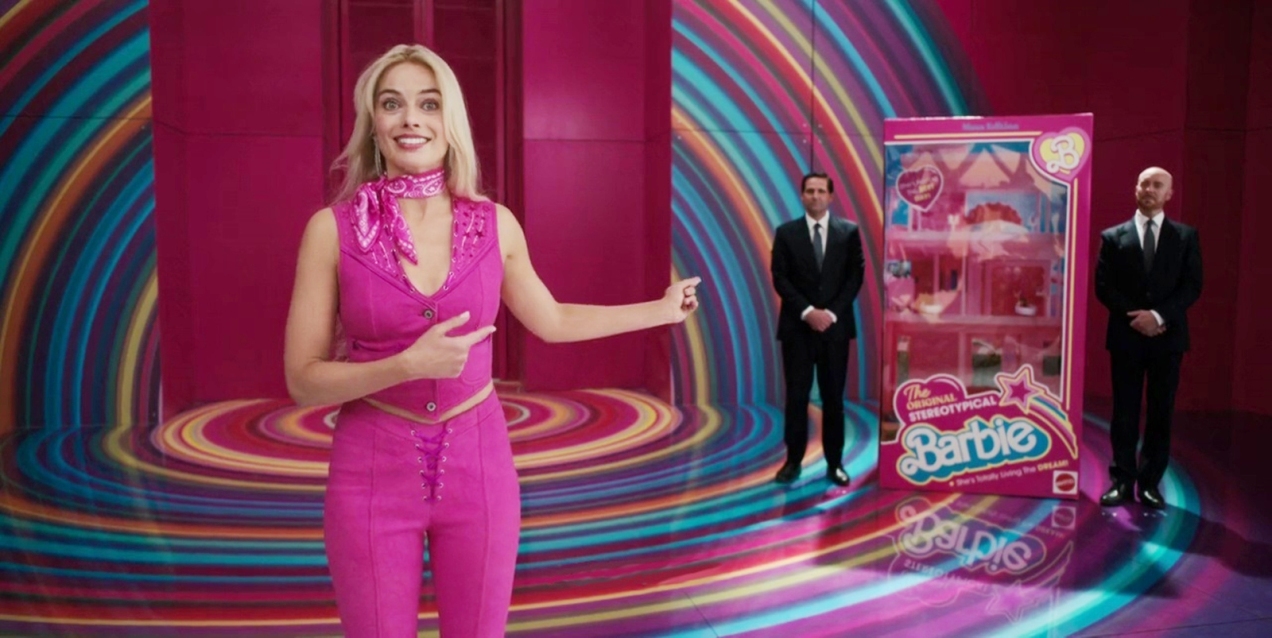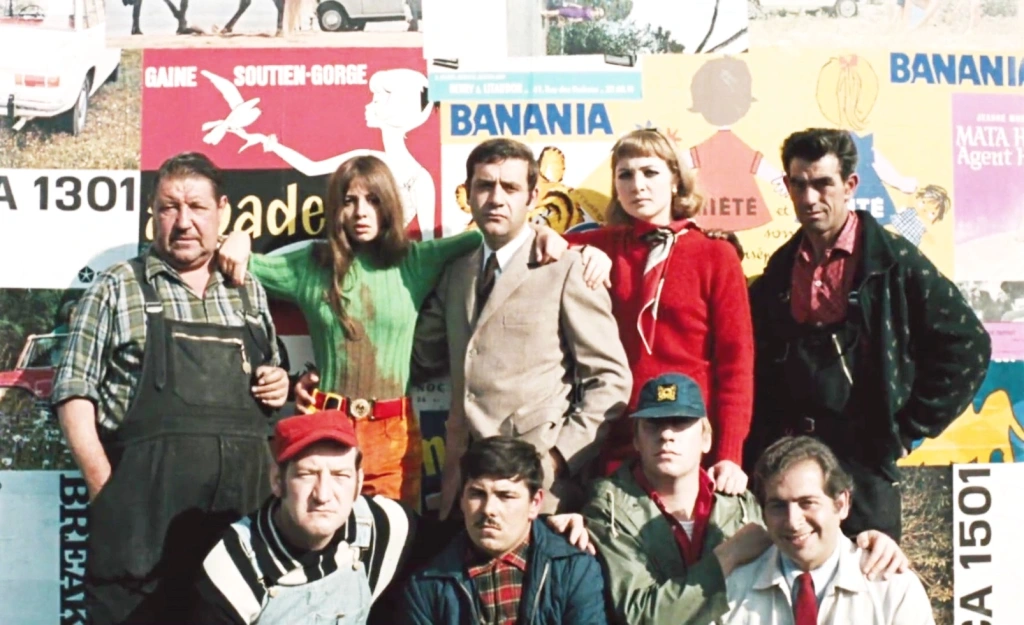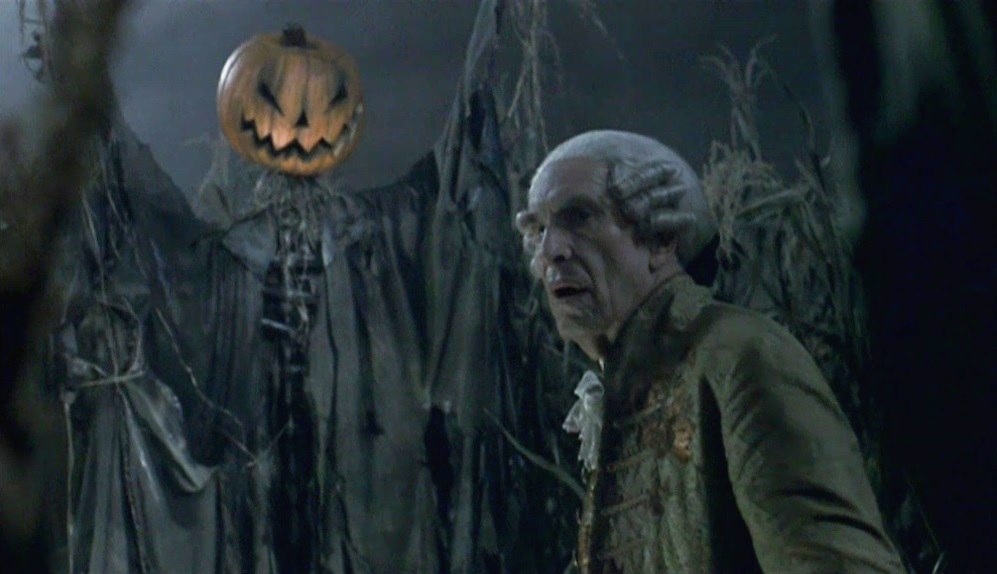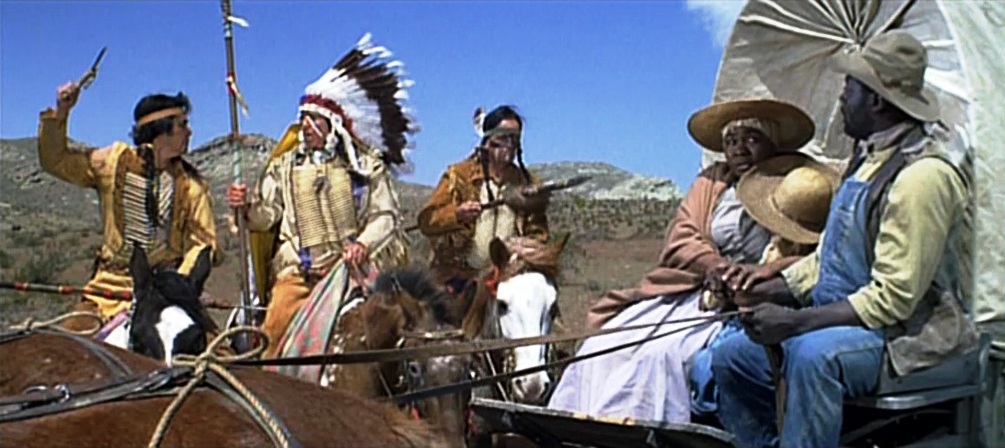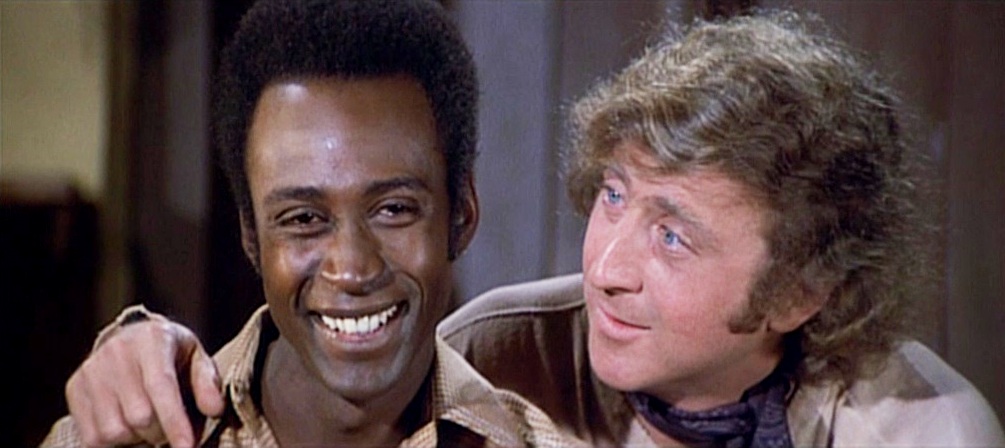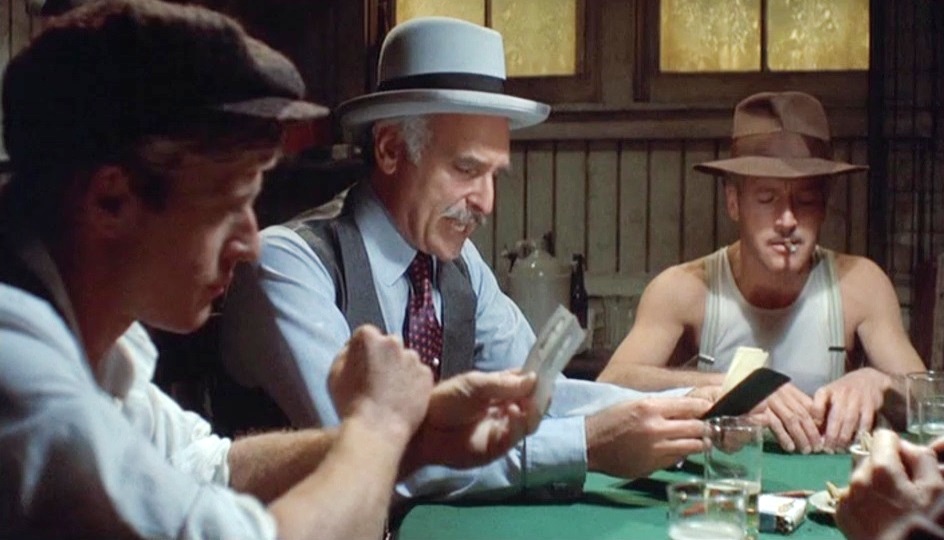.

Director: Greta Gerwig
Screenwriters: Noah Baumbach, Greta Gerwig
By Roderick Heath
Future cineastes and cultural scholars – and everyone else in a year’s time – might need to be told just exactly what the “Barbenheimer” phenomenon was, so much like Helen Mirren’s dulcet-toned narrator as sported by Greta Gerwig’s Barbie, I will explain in brief. Barbie and Christopher Nolan’s Oppenheimer, two big-budget, high-profile films were scheduled for release on the same day in A.D. 2023. Such was the stark schism of the opposition – one, so advertising made clear, a bright, brash take on a very girly property, the other an epic exploration of really serious history stuff directed by millennial males’ anointed god-king auteur – that it formed a perfect diptych of pop cultural stances, aesthetics, and audiences. This became, as so many things do these days, a topic of internet fun, and this in turn evolved into a semi-accidental viral marketing campaign, revolving around the way many potential viewers refused to choose between them, and instead went to see both. The result was propitious for the box office, after a dismal season for both audiences and Hollywood studios whose liberal servings of burned-out franchises and genres met only general apathy. Barbie and Oppenheimer were both big hits, although as to be expected the former proved by far the bigger. You can’t argue with success, as the old saying goes – and yet the very existence of art criticism as an intellectual process is predicated around doing just that – and Barbie’s success might preclude contemplating just what it succeeds at: the film obviously hit home, so what’s the problem?

Personally, I felt it beholden on me to sit out such a phenomenon as the “Barbenheimer” craze, both on general principle, because it was just goddamn embarrassing, and given my lack of great interest in either movie, although I knew well I’d get around to both eventually. So, finally I watched Barbie, and whilst it’s undeniably been a pop cultural phenomenon, what a peculiar one it is. Firstly, there’s the amusing and slightly bewildering fact that one of the biggest financial successes of recent times has been made by Greta Gerwig, the one-time muse of mumblecore, in writing collaboration with her romantic and professional partner Noah Baumbach. To be fair, their last behind-the-camera collaboration, the Baumbach-directed, Gerwig-written Mistress America (2015), is for me by far the best work either has done – indeed, the only time I’ve been able to stomach Baumbach at all. Gerwig debuted as director with 2017’s Lady Bird, and followed it with 2019’s Little Women, both swiftly lauded by a movie culture urgently hungry for an American female director to celebrate, particularly one who, despite her roots in a fastidiously quirky and anti-populist wing of independent film, emerged with a desire to make films with largesse of style and feeling befitting mainstream appeal whilst retaining an artist’s finesse. Lady Bird was a well-done if familiar portrait of a teenaged girl blessed with an outsized if not unjustified conviction of her own anointed destiny, the second a revisionist-tinged take on the ever-popular Louisa May Alcott novel.

The connection between Gerwig’s script for Mistress America and her two films as director was a focus on energetic, self-willed young women with creative spark and a determination to make something of it rather than get sucked down into the vortex of petty relationships. In Lady Bird and Little Women, the price paid for indulging such vision was a painful realisation of childhood’s end and the opening gateway of real adult difficulty, where nobody else gives much of a damn about your talent or ambition, and indeed some might well take delight in destroying them out of spite in the eternal snooker match of individual will and ego – a match that so often feels, at least as it’s often framed, indivisible from male-female relations. Barbie essentially takes up these fundamental concerns too, even as it seems to swap out the human focus of the indie bildungsroman and the classic literary adaptation for a cross-pollinating marketing event and corporate synergy spectacle. The doll known as Barbie was released 1959, the creation of Ruth Handler, whose husband was an executive at the toy company Mattel. Although hardly the first adult female doll created and marketed – Handler found a model for her idea in the German “Bild Lilli” – Barbie nonetheless hit a bullseye with a changing culture in offering girls a figure to project adult roles onto, and their own perception of themselves in those roles, via a fantasy extrapolation of a mid-20th century Californian lifestyle ideal, where the women are tall and glossy, the cars shiny and fast, the houses open-plan, and the men all surf.
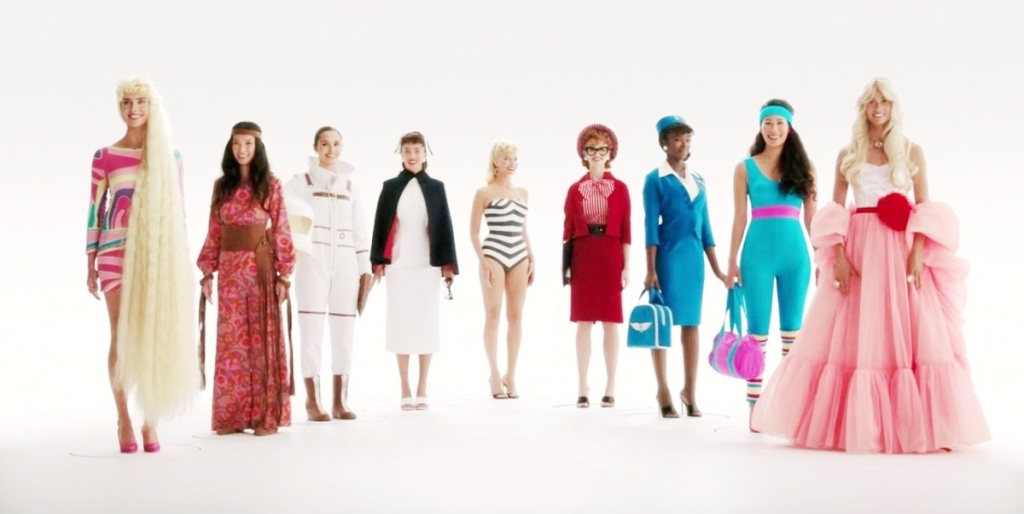
Gerwig’s Barbie mythologises this advent in broadly satirical terms at the outset by enacting Barbie’s first appearance as a lampoon of the opening scenes of Stanley Kubrick’s 2001: A Space Odyssey (1968), and narrated by Mirren. Barbie, as personified by Margot Robbie, takes the place of the Black Monolith and a collection of girls, dressed like Depression-era waifs, joyously embrace the new doll and savagely smash their old, childlike dolls. A broadly amusing opening that nonetheless set my teeth on edge, as Gerwig leans on possibly the most over-used satirical reference point in modern culture, already done to death in a few hundred different ways, and yet has still been lauded by much of the commentariat at the product of a fresh vision. The most interesting and disconcerting thing about the way Gerwig and Baumbach take on their task, which, in their own terms, can be happily seen in Schrodinger-esque terms simultaneously as a sell-out and a heroic grasp at connection with the largest audience deserved and possible. They have not made Barbie the story of the character represented by the dolls: what single character could conflate the legion that is Barbie? Instead, the film is a study of the idea of Barbie, its place in the modern psyche and the complexity of her legacy. Later in the film Handler herself, or rather her inhabiting spirit as personified by Rhea Perlman, is introduced as a sensei for her creation as she faces evolution.

Broadly it can be said the story’s chief objective is to put Barbie as both heroine and concept through all the tortures of cultural doubt before re-enshrining her as that vital expression of modern femininity. Granted, there was inherent difficulty in taking on Barbie, which required some sort of imaginative and conceptual frame being applied to her. Barbie has long had a fictional biography in which certain elements are set despite all the varieties of her marketed over the intervening 60-plus years: her full name is Barbara Millicent Roberts, and her on-again-off-again boyfriend has been Kenneth Sean ‘Ken’ Carson (there was a brief interregnum in the early 2010s when she was paired with an Aussie surfer named Blaine). But Barbie isn’t a figurine that comes armed with some awesome sci-fi or fantasy backstory like the Transformers or He-Man or the panoply of Star Wars action figures I grew up with. In actual function, Barbie is a tabula rasa of projection, identified by her interchangeable identity, persona expressed through lifestyle accessorising. When I was but a lad, Barbie was a yucky girly thing, of course, but also intrigued me. Barbie was so multitudinous, so free, whereas, say, the Transformers were designated, even trapped by their appointed roles and guises. Barbie the film meditates on the double-edged sword that is this scope, seeing that very endless possibility as also a desert of actuality. In terms of modern feminist iconography, Barbie is a taunting figure, at once integral and vilified, the perfect expression of one version of its ideals and the Judas goat of others.

Gerwig casts Robbie as Barbie, a piece of casting so obvious it seems predestined – Robbie has not just the ideal looks but the right cleverness as a performer to simultaneously capture the gleam of beatific self-containment in Barbie’s smile and eyes and the shimmer of panic Gerwig seeks. The film jumps off from similar precepts to many recent movies dealing with porous boundaries between the real and imagined. Close kin is Phil Lord and Christopher Miller’s The LEGO Movie (2016), to which Barbie can indeed be taken as a kind of franchise extension – the presence of Will Ferrell in both as closer to a mascot than a comedy actor highlights the connection – in that it takes the messiness of commercial character canons as not something to be glossed over but a source of merriment in and of itself, in an age when arguments over canons are the stuff of both endless fan complaint and urgent intellectual contention. There are nods to discontinued or barely remembered brand offshoots, realised with stunt casting: director Emerald Fennell is glimpsed as Midge, a short-lived pregnant doll marketed by Mattel, and Michael Cera, exiled for some time now as a semi-star whom audiences liked but couldn’t find a niche as a performer, plays Allan, the one non-Ken male in Barbieland (who, as is incidentally noted in the end credits in a manner that’s funnier than anything the actual movie does with him, was featured in vintage advertising starkly and questionably as “Ken’s friend.”) Oh, and Barbieland? Well, it subsists in a sort of Platonic void connected to the Real World in a nebulous way, with travelling between the two requiring a multi-stage, ritualistic commute involving driving and then rollerblading.

Barbieland is the product of the Real World’s collective consciousness, willed into existence and reacting to pressures from the Real World in a barometric manner. Barbies who have been played with too much or in a perverse and destructive manner, represented specifically by “Weird Barbie” (Kate McKinnon), show the wear and tear inflicted by their owners. Robbie specifically plays “Stereotypical Barbie,” blonde and statuesque, the original gangsta, what she herself describes as “the Barbie you think of when someone says ‘Think of a Barbie’” (notwithstanding that a black-haired Barbie was released simultaneous to the blonde one at the beginning; popular proclivity decided which was the most desired). After the 2001 riff, the film segues into an amusingly campy-jaunty depiction of Barbie awakening in her Dream House, waving to all her fellow Barbies, who are actualisations of the many variants put out by Mattel. They all reside in their similar Dream Houses which have no walls and go through the motions of preparing for the day, including showers with no actual water and breakfast with no actual food. The day-glo sprawl is scored with an upbeat anthem by costar Issa Rae, who also plays President Barbie. The Barbies fill every role of government and society, whilst the populace of Kens all dedicate themselves to the mysterious profession referred to as “Beach” – that is, well, hanging out on the beach and occasionally taking the risk of venturing into the plastic surf.

Barbie is at its best here in conjuring a cartoonish, wryly question-deflecting extrapolation of the existence of Barbieland as sustained by the average 7-year-old girl’s imaginative impositions on her dolls, and the fantasy concept of adult life realised through that playing. Far from representing a total rejection of maternal instinct in girls, Barbie and her ilk allow a simultaneous existence as mother and child, constructor of identity and construction, and recognition of how that process is essentially one of a lifetime. The film of course puckishly defies viewers to make any kind of logical sense out of the relationship between Barbieland and reality (if Stereotypical Barbie is perverted by a real-world owner, does that turn her into Weird Barbie? Or does she join with Weird Barbie in a kind of gestalt? Does a new Stereotypical Barbie arise to take her place like a pod person?…okay Rod, stop. Leave it to whichever YouTuber is dedicating themselves to that sort of pondering). But one subtly pervasive problem with Barbie also quickly emerges as the classical Ken (Ryan Gosling), Stereotypical Barbie’s sort-of boyfriend, confronts one of his rival variants (Simu Liu), and the two provoke each-other into having a “beach-off,” repeating the joke a half a dozen times to make sure we catch the likeness to “beat off.” This signals the level on which many of the actual, proper jokes in the film will be pitched on, as well as also evincing its sarcastically reductive take on the Kens as representative boy-men who are really only happy when playing with themselves.

Mirren’s narration explicitly sums up Gosling-Ken in one voiceover line, noting that he “only has a great day when Barbie looks at him.” The irony of this element of Barbie proves to not be an aside but central to the movie’s whole proposal. In Barbieworld the usual pattern of classical masculine and feminine relations – or at least the rhetorical, sentimental, Victorian version thereof as still seems to persist in the mind of the imagined collective grandmothers of today’s women (and Mike Pence) – are inverted. The Kens are essentially pretty, idle objects who only have identity in relation to the Barbies. That’s always been pretty true of the doll line, Ken a perpetually present but emasculated (notwithstanding his infamous lack of anatomy) adjunct to the mystique of Barbie, one whose fluctuations of identity and relevance to her has changed according to the whim of the moment’s messaging. That pattern is continued here when the climax denies any kind of romantic liaison for the pair. The film might have had a certain amount of sport with the inversion whilst also commenting ironically on it, whilst portraying a stumble towards a more egalitarian world in a wryly inverted portrait of modern gender politics. And yet the actual social make-up of Barbieland is kept entirely vague, despite the latter part of the plot hinging on the Kens’ efforts to change its constitution to enshrine male power whilst never defining its version of female power. There’s an odd kind of defensive hypocrisy hiding in here, in a film that might well argue it’s not worth interrogating in that manner, which then raises the question on why it feels the need to comment on such things at all if it doesn’t want to be taken seriously on them.

Meanwhile life in Barbieland proceeds through an endless roundelay of joyous frivolity and wishful thinking, evenings usually capped by dance parties and girls’ nights that inevitably see Ken chagrined to be urged on homeward after failing to woo Barbie. However, Stereotypical Barbie, who I will just call Barbie henceforth, who has already started to mysteriously suffer her feet suddenly refusing to conform to their usual, tippy-toed, high-heel-ready posture, starts randomly expressing morbid thoughts whilst burning up the dance floor. This moment instantly became an online meme, a remarkable feat for a film that is itself almost entirely comprised of harvested memes. This moment for instance replicates a brand of hipster humour already pretty familiar in pop culture. Barbie’s biggest rival at the 2023 box office thus far, Aaron Horvath and Michael Jelenic’s The Super Mario Bros. Movie, had a cute cartoon character locked in a prison uttering statements of morbid and depressive import to the chagrin of fellow captives. Granted, modern Hollywood is usually at a long, long lag behind contemporary pop culture mutations, which can literally wax and wane in the space of days, even hours thanks to online life, which means that trying to chase those trends, whilst programmed deep in Hollywood’s DNA, is just about always a losing proposition. Unless, like Barbie, you try to become the Point of Singularity for memes. Almost all of the film’s jokes and flourishes of social commentary depend on some variety instant assimilation factor that’s key to the way memes work. A rhetorical set-piece comes when Gloria goes off in a rant about the impossibility of being a woman, a speech that’s supposed to have the power of radicalising the Barbies but feels like it was accumulated with an AI filter. It reminded me of when I tapped out of Charlie’s Angels (2019), when the film deployed a commonly shared joke on Facebook involving women’s supposed slavish love of cheese.

Anyway: Barbie’s disconcerted new awareness of mortality, dysmorphia, and indulgence of morbid trains of thought drives her into a crisis. She consults with a coterie of fellow Barbies, including President Barbie (Rae), Lawyer Barbie (Sharon Rooney), Writer Barbie (Alexandra Shipp), and Physicist Barbie (Emma Mackey), and they direct her to Weird Barbie. Weird Barbie, who has a bad haircut and texta scrawl on her face and is usually to be found with legs perpetually splayed in the splits, explains what’s going down: Barbie is being affected by being played with in an unusual fashion by someone in the Real World. Barbie resolves to travel there and contact whoever this person is, and Gosling-Ken sneaks into the boot of her car to tag along. Going through the ritual process of commuting, Barbie and Ken arrive on Venice Beach, where Barbie immediately encounters sexism, being leered at and pawed by various jerky men, including some construction workers who nonetheless prove bewildered and acquiescent when she admits to lacking private parts, whilst Ken boasts of having “all the genitalia.” Both are arrested repeatedly for their odd behaviour and try to adopt a low profile by changing clothes – although the garish new outfits they put on, including Barbie’s hot pink cowgirl outfit, fail badly at the job.

Barbie manages, by forcing herself to settle down and mind-meld with the psyche influencing her, to zero in on a teenaged girl named Sasha (Ariana Greenblatt), daughter of Gloria (America Ferrera), who works at Mattel’s corporate headquarters, manning a desk that guards the boardroom. When Barbie tracks Sasha to her high school and introduces herself, expecting to immediately set everything in the girl’s mind to rights, Sasha, whilst assuming “Barbie” is some nut, then unleashes a spray of invective against the entire concept and function of her character, concluding with that most would-be devastating of punch-lines: calling her a fascist. The Mattel executives, headed by a gruff but hapless CEO (Ferrell), learn of the arrival of the two dolls and go on the alert, setting out to recapture them and restore them to the fictional realm before, well, something happens. Meanwhile Ken, startled when someone gives him a show of casual respect, soon realises the inverted status he possesses in the Real World. He immediately resolves to nab himself a job that suits his newfound sense of self-importance, only to find that he can’t simply become a doctor or even a lifeguard – the closest thing to Beach he can find – without some sort of qualifications. So, he decides instead to learn all he can about patriarchy and take it to Barbieland, where he can indulge its assumed pleasures without any of its commensurate demands.

Barbie is interestingly confused when it comes to its take on patriarchy, a buzzword it leans on with all the relentlessness of a 14-year-old blogger. It’s something Gerwig and Baumbach simultaneously portray as so intoxicating that it readily subsumes Barbieland, and as a paradigm rooted in things that still must be earned and strived for, which somewhat ironically contrasts the easy-peasy gleam of fantasy achievement in Barbieland. Certainly interesting territory to dig into, but also something Barbie shies away from, instead turning towards a lampoon of blokey obsessions as long parsed by folks on Twitt– er, X: the film crams in jokes about guys who love Pavement and The Godfather and will explain them at length. Of course, I’m not the target audience for all this (then again I don’t particularly like the idea of target audiences; a work of art should theoretically be capable of holding anyone) and indeed I might well be the target, period: am I not an opinionated guy who likes over-explaining things on the internet? But I was less aggravated by the tenor of all this then I was by the obviousness of it, the meme-ness of it. And the problem indeed that keeps prodding me about Barbie and its overall intellectual project, if it isn’t gilding the lily on a biblical scale to call it that, is that it proposes to make a movie about a beloved feminine figure, and makes her story about men. Not simply that, given the plethora of directions it might have taken, it chose to be driven by the clash between the girly things and boy stuff, but in that it makes Barbie herself, and by extension Robbie in playing the role, an inert, hapless, buffeted figure. Barbie gives nothing to the Real World as it’s portrayed, not even getting a chance to spice up the lives of the poor, Beach-less proles of reality. Her greatest dramatic feat is to start crying when she connects with Sasha in the Real World.

Meanwhile the movie farms out all the fun stuff to Gosling. He gets the song and dance numbers, the absurdly intense and inchoate emotions to play, the excitably yammered meditations on the things that stir his fantasies and provoke him to enact them. Certainly there’s a variety of female gazing apparent here, delighting in Gosling and the other actors playing Kens parading themselves in self-consciously hot-silly play. Barbie does by the end come up with a plan to reconquer her fiefdom, but only in a way that exemplifies a particular sexist cliché – women manipulate men through stirring their jealousy and playing upon their emotions, a trap that prove as defenceless before as the women of Barbieland were to their newly, bullishly macho ways. The film does strain to say something interesting about the kind of ultra-macho reflexes of a certain coterie of modern young men as represented by Gosling-Ken in angrily and frustratedly seeking a version of masculinity that rejects need for female attention and yet down deep inside actually represents another hoped-for way of gaining that attention. But to follow the same logic, the movie’s messaging in regards to this about the status of women actually suggests that unless they’re supervising themselves with a rule of rigid iron, women are fatally predisposed to being willingly dominated by men, which is surely not what was intended. Oh, no, wait the movie defines them as “brainwashed” by means unknown. Does any idea let loose in Barbieland just automatically persuade everyone there?

The story of my reaction to Barbie is bound up with the way it utilises two songs – Matchbox 20’s “Push” and Aqua’s “Barbie Girl.” The inclusion of the latter song was practically inevitable despite Mattel’s well-known aversion to the song. The company sued the Scandinavian dance-pop band over it back when, officially for infringing their copyright, but in truth more for their insidiously catchy defloration of the doll’s mystique. Aqua’s song plays up the sex object aspect of the doll’s allure, defining her as a “blonde bimbo girl in a fantasy world” with whom one can “touch me hair, undress me everywhere…you can touch, you can play, you can say I’m always yours.” The inspiration for the song came for the band when its members visited an exhibition on camp culture, and they came up with an irrepressibly festive and horny song for the irrepressibly festive and horny late 1990s. The idea that a Barbie movie could come out in 2023 and not include the song would strike most audience members as entirely mystifying if not actively, outrageously disappointing. So the film, as it so often does, has its cake and eats it, sidestepping potential dissonance by including a sampled version of the song by with new, rapped lyrics by Rae.

I can sympathise with the filmmakers and their brand-protecting backers to a degree with this: it might seem a little incoherent to include a song that makes such sport of the character you’re trying to celebrate in a manner that can be readily sold to children, and cuts against the grain of the whole idea that Barbie is more than just a dubious depiction of pulchritude. Trouble is, though, the song is cleverer and more multileveled than the film. In part that’s thanks to singer Lene Nystrøm’s phrasing, which invests a note of pathos to the character: her Barbie is at once appealing and forlorn, alternatively a minxy, celebratory figure and a construction offering thrills she knows and we know are cheap, transitory, illusory, a simulacrum accepted on the path to actually finding a true vessel of desire. This note gives way to the back and forth of her lyrics with fellow vocalist René Dif as the song’s take on Ken, investing it with both its signature call-and-response delight in coupling and a strong hint of role-playing: the song’s Ken and Barbie are adults projecting their mature sexuality onto their childhood avatars.
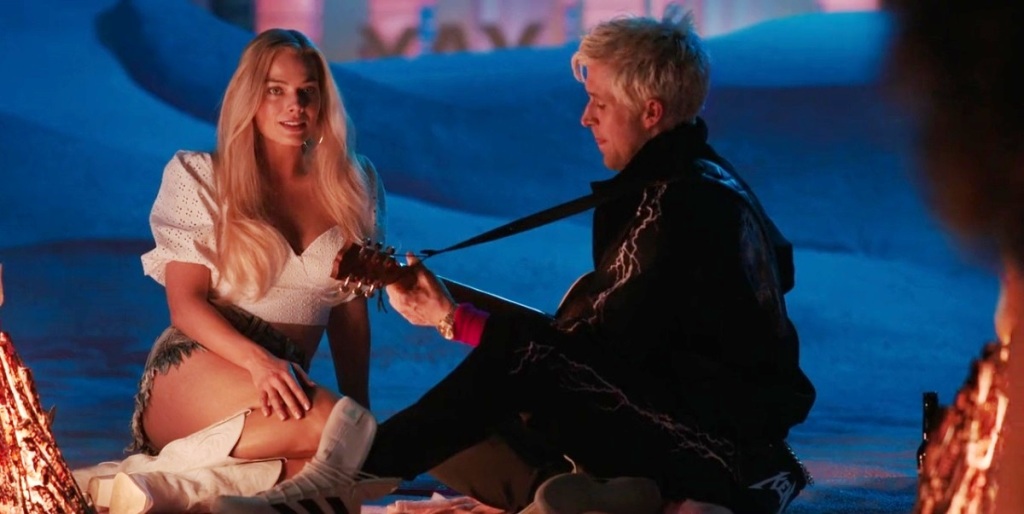
“Push”, on the other hand, seems like an entirely different kind of musical product, as a rock song from the same period with that genre’s more familiar masculine voice, with singer Rob Thomas voicing the story of an insecure and troubled young man who admits to the dark urge to bully and dominate his lover, recognising the forbidden emotional thrill of asserting power over another. Gerwig uses the song in a peculiar manner, at once sarcastic but also taking the song’s meaning in the most literal way: the Kens sing it to expostulate their project directly whilst affecting intimate crooning in a cold satire on the mystique of the male musician and his pliantly mesmerised partner, until Barbie explicitly encourages her fellows to “pretend you’re interested in the song” long enough to get what they want. Granted, there was something highly calculated about Matchbox 20’s version, affecting raw and edgy expression of verboten feeling whilst maintaining a veneer of slickness in sound and song structuring that made them ideal radio fodder at a time when rock was struggling to hold onto that niche. Possibly too it has some personal meaning for Gerwig – perhaps she associates with some douchey ex, or just annoys her.

But the film’s use of the song has the intrinsic effect of redefining the song in a particularly detestable way, robbing it of any stature in acknowledging that real art usually requires pushing against the comfort of polite society to some degree. That’s not uncommon today when the concept of “poptimism” often exalts upbeat messages and aesthetics and decries the cult of transgression as simply giving professional jerks space to mask and justify themselves. Gerwig tries to have it both ways in this regard: Barbie, despite its occasionally sardonic swipes at a poptimist culture duty-bound to dole out positive bromides, is nonetheless a pure product of it, diagnosing the aggression in other styles whilst wielding its own specific wavelength of passive-aggression. Both “Push” and “Barbie Girl” are then both still actually much more subversive than Barbie as pop culture artefacts. Yes, Barbie put me in the position of defending Matchbox 20, and I’ll never forgive it for that.

More immediately, casting Gosling as Ken was a stroke of genius, at least from a commercial angle, and to a degree artistically as well. Gosling is a rare commodity in current film: an intelligent actor, he’s one who affects a baseline persona of blasé cool that does much to make him popular but which he can play with like a master musician, and his attractiveness to the opposite sex is so potent it has long sustained a sort of imaginative universe of its own not unlike Barbieland. A popular series of online memes from the mid-2010s sported images of Gosling with text mixing feminist rhetoric and romantic overtures, in a simultaneous mockery and indulgence of Gosling’s dreamboat appeal and its destabilising effect on female cognisance. Gerwig knows this well, and as well as anchoring the film with a beloved star wittily cast, she accesses this astral plane of meme energy and adds it to the many others the film consists of. Thing is, Gosling-Ken is the film’s motivating character, both protagonist and antagonist. Ninety percent of the film’s humour, story, and general all-round affectation of good vibes depend entirely on Gosling and his capacity to sell the dichotomy at the film’s aesthetic and thematic heart. There’s something bitterly, hilariously apt about a film that sets out to celebrate a female icon instead chiefly rendering itself a vehicle for a male star’s charisma and comic chops through its constant second-guessing and attempts to be ahead of the curve.

And yet Gosling is also miscast. He readily projects his take on Ken’s mix of boyish eagerness and sullenness when he realises he’s been sucking on the hind teat all his existence, and he sports a decent six-pack. But he’s far too cool and cagey a presence to play a character who’s famous as a vacuous placeholder for masculinity in an otherwise gynocratic universe: he doesn’t just let us in on the joke but smothers us with it. Perhaps the ideal Ken would have been an actor of another age, someone like Rock Hudson or Tab Hunter, experts at concealing their actual identities whilst projecting exteriors of igneous fantasy masculinity and just occasionally letting that actual identity show through with a flash of knowing humour and existential panic. I wondered if Channing Tatum, who’s made a career out of deftly exploiting and mocking his external adherence to a stereotype of good-natured, rather dim male sexiness, might have been a more apt modern equivalent.

Meanwhile the film happily indulges a purely liberal-left feminist fantasy, like its depiction of how it thinks justice should work, with women lawyers appealing to women judges and gaining perfect progressive results. Lawyer Barbie deftly hacks apart arguments about corporations having personal rights, defining that as mere plutocracy, and the Judge Barbie (Ana Cruz Kayne) readily agree. If I was feeling particularly cynical – and I am – I might say this beautifully describes the mindset of online life as it relates to politics today, a world where one can engage in a perfect version of political, legal, and social thought where one does not have to contend with a rival perspective, save to take safe-distance swipes at it. The wish-fulfilment aspect of this scene is worn on the sleeve, and the appeal is obvious enough. Feminism – or at least, feminism in the American political paradigm, which is the only kind Hollywood recognises despite its pretences to speaking to the world – is in a rather glum if hardly defeated place following the striking down of Roe vs Wade by the reactionary-packed US Supreme Court, and indeed has been in mounting convulsions ever since Hillary Clinton was beaten by Barack Obama in the identity politics-as-actual politics stakes, let alone when Donald Trump came along. The entire philosophical essence of progressivism is that it’s supposed to, well, progress, so what is called when change is backwards?

I note this because Barbie is a film that wants to be bitingly ironic, under all the froth and pastels, about the relationship between personal fantasy and social reality, whilst falling into its own trap. The film’s plot extends this concept and problem on multiple levels. When Barbie and Ken finally travel to the real world, Barbie is shocked to find that the existence of her role-model universe has not impacted the real one, and in fact the opposite ultimately proves true: the insidious influence of maleness is especially virulent when released in the un-inoculated climes of Barbieland. I could take this as the film’s most inspired satirical tilt at our contemporary tendency to stay within bubbles of curated content and feedback loops of self-approved messaging, and the way it offers a kind of illusory buttress community that too often proves extremely vulnerable. I’m not actually sure if the film is aware of this element, but I’ll still credit it as such. Trouble is, Gerwig communicates all this through the dramatic version of memes – tropes, many of which, like leering, catcalling construction workers, have a rather backdated feel. It’s satire, but it commits one of the worst potential crimes of satire in being essentially reassuring, taking refuge in familiar caricatures of problems and enemies.

Ferrell’s CEO exemplifies the fuzziness: he’s both a variation on Ferrell’s Ron Burgundy persona with his walrus-like pulled-in chin and forced deep voice affecting an imitation of old-school male authority whilst also mouthing contemporary virtue signalling the film takes the mildest of mild whacks at. I couldn’t help but mentally note that the Supreme Court that handed down Roe vs Wade was entirely male and the one that struck down abortion had four women members, but the film’s finale sports a gag where the Kens are promised some kind of low-down judgeship in a kind of mockery of balance, a touch that’s more than a little insufferable, not least because it feels like it’s running away from the film’s supposed theme, that reality doesn’t always work like it does in ideal universes. Barbie proves then an example of what it proposes to critique, the bubble it wants to bust. On a more artistic level, certainly nothing here is comparable to the way Todd Haynes utilised the Barbie mystique for wicked critical ends in his first, best film, Superstar: The Karen Carpenter Story (1987), where he used the dolls to act out the biography of the singer’s tragic life whilst reflecting back at media image-making its own hall-of-mirrors tendency to entrap people within ideals. The undervalued sequel to The LEGO Movie, The Second Part (2019), already meditated with more real insight and real bounce on the differences between boy and girl play, the openness of the latter to incorporating different ways of being as represented by different types of toy compared to the ruthlessly genre-and-gender-dividing tendency of boys. One disappointing aspect of Barbie is that despite literally being about toys, it doesn’t actually have any interest in what play is and what it means for kids. Point in fact, Barbie the movie is indifferent to what actual kids will make of it. It’s made instead for a grown-up audience: mother and daughter duos like Sasha and Gloria very likely enjoyed it together, but kids of the proper age age to play with Barbies will likely squint at the screen in a certain amount of perplexity and wonder why does this movie hate Barbie and everything about her?

What should be the true core of the film’s emotional and thematic energy – the relationship of Gloria and Sasha and the way their mutual encounter with Barbie helps them all transform each-other, isn’t just neglected but basically forgotten in the clumsiness of the second half. Sasha is presented as a veritable caricature of an angry, accusatory teen, one who actively disdains her mother, but by movie’s end they’re reconciled because, well, the movie says so. Eventually it emerges that it’s actually Gloria who’s been playing with Sasha’s old Barbie and thus has inflicted her own adult dubiety on Barbie – this making her in essence a stand-in for Gerwig herself. Gloria herself likes sketching new Barbie concepts at work. Later Sasha tells Gloria she’s weird and wild or some crap, but her concepts as put on paper are banal and merely have oddball names attached. At the climax Gloria offers her singular great idea to the Mattel honchos – Ordinary Barbie, an idea the CEO scoffs at until one of his team tells him it will make money based on some obscure bit of number-crunching, a moment that feels again like a bit of self-reference from Gerwig to the movie’s development, but in context feels entirely limp, almost making fun of its own lack of some genuinely inspired and clever way of resolving its plot and ideas, of wrestling with the difficulty of creation.

Stylistically, Barbie leans extremely heavily on aesthetics borrowed from Wes Anderson, with the deliberately flat, almost cartoon-illustration-like visuals in the Barbieland scenes, and stylised, declarative performing a la Whit Stillman, for whom Gerwig did sterling service as an actor back in Damsels In Distress (2011). Touches like Allan opening a can of whoop-ass on some Kens to give Gloria and Sasha time to pull off an escape, only for the action to fade into the inconsequential background, likewise replicate similar touches in knockabout comedy of the last 20 years. As mentioned, Barbie does at least extend Gerwig’s oeuvre coherently, particularly in its loss-of-childhood aspect. Like the vast number of actors-turned-filmmakers, Gerwig had previously displayed a masterful touch with her cast. The best moments of Little Women, like Jo and Laurie dancing up a storm or the alternations of pathos and fury enacted by Jo and Amy, depended on a precise sense of what her performers could achieve, the way their liveliness can infuse a seemingly staid project and shock it with new life, in a manner I found more effective than its more overt attempts to get openly post-modern in its approach to a well-known work of fiction (Alcott’s openness to a different version of marriage for Jo was more transgressive and relevant today than Gerwig’s snobbery about it). Regardless, Barbie doesn’t have the same precision in performance. The alternations of silliness and sourness in the second half in depicting Ken’s campaign often gave me the feeling of a slightly mismatched rhythm, Gosling called upon to deliver chain-lightning quips in a way that often makes them garbled, almost as if the film kind of wants to hurry past them so we won’t think too hard about what’s actually happening.

I could forgive every topic of tetchy kvetching I’ve brought up here if I found Barbie fun and funny often enough to make it all inconsequential. But the aspects of Barbie that are genuinely fun are disposed of pretty early, and the movie goes on for another hour and a half. I found something kept bleeding the humour value out of it, something beyond the way a lot of its gags are borrowed from other sources. Part of the problem is the awkwardness of pacing and staging the humour I’ve noted. The one really good laugh I got came from the “Depression Barbie” ad that plays when Barbie is at her lowest: whilst it is in many ways only the umpteenth variation on the same joke in the film, it came as such a brilliantly deployed moment of stylistic lampooning that it hit the mark, even if it still comes with the codicil that it plays at making fun of the advertising the movie is actually, ultimately merely a very long version of. Gerwig later stages a song-and-dance number for the Kens where they struggle with their identity, pushing through the conflict the Barbies have stirred them to and arriving back at a point of collective reconciliation only to find they’ve been outmanoeuvred in the meantime.

The battle of the Kens on the beach is a gleefully ridiculous spectacle that doesn’t so much embrace campiness as bunk down, file a joint tax return, and buy a house in Malibu with it, even if it’s that modern, scrubbed-clean, Instagram-filter-esque idea of campiness that has no edge of danger or actual sexuality to it. The subsequent musical sequence, with Gosling leading the other Ken actors – their ranks also include the likes of Kingsley Ben-Adir and Ncuti Gatwa – do much to return the movie to its early, cartoonish style, and indeed it makes me wonder why Gerwig didn’t extend the neo-musical conceit. Given that Barbie is about the five millionth recent movie to betray the influence of The Simpsons TV series, I felt the film ought to have patterned itself more overtly on the “Wild Barts Can’t Be Broken” episode with its climactic musical number of clashing social groups and their articulated gripes managed to perfectly dovetail overarching satire and specifics of character. Instead, the film resolves in interminable fashion, rambling on for some fifteen minutes or so once the actual plot has conked out. The Kens have been outwitted by the Barbies, giving way to a long coda where everyone stands around talking about stuff: Ken confesses the insecurities that drove him to his insurrection, Gloria makes her product pitch, and Barbie is visited by the shade of Handler.

All this leads to Barbie choosing humanity, an assimilation Gerwig illustrates with a reel of home movies from members of her cast and crew – another interesting idea rendered fuzzy in effect, in part because there’s no clear connection between these images and what’s supposed to be happening, and because there’s a thematic incoherence in here the film remains blithely indifferent to. Gerwig insists Barbie must become a real woman for no other reason than its need that to be its ending: surely, it implies, being a real woman must in the end be preferable to being a fantasy one. The nature of Barbie’s transition is rammed home in its punchline as Barbie visits a gynaecologist for the first time before a shock cut to black, the filmmaking equivalent of an ain’t-I-naughty smirk. The point here is plain enough: being a real woman is something that revolves around a basic fact of biological structure (notwithstanding trans experience, but let’s not open up that can of worms), and that basic fact is a gift that also comes with responsibility, a notion that resonates again with definite political ramifications. But this point again floats free of the actual story being told, which has stuck up for the ultimate necessity of imagined ideals in contrast to the mess of reality, and Barbie’s stature as a representative ideal, on top of the fact that the film gives no comprehensible reason why she wants to choose reality, which is presented as antithetical to everyone she is and desires to defend.

If I’ve talked more about ideas and artefacts encircling Barbie more than the film itself, well, my justification for this is that’s what the film itself does. As an actual narrative film, Barbie is so thin as to barely exist. Not that there’s anything wrong with that – some of the greatest films ever made, particularly the classic musicals Gerwig sometimes channels in her stylisation, basically float like soft and shimmering clouds of ethereal expression. But those film commune with the ethereal; Barbie gropes through it. The trouble is, Barbie wants oh so hard to be about something, but its about-something-ness trumps what it’s actually about, its own narrative and stylistic gestures barely adding up to more than an extended pastiche and a list of thematic bullet points, self-awareness without a self to be aware of. The nominal plot and characters, the emotional and conceptual sinews of the movie – these are helplessly garbled and sporadic, its cumulative expression of meaning contradictory. All of this is churlish on so many levels, I know. For those who just came to get the sugar rush of bright colours, pleasant nostalgia blended with a light spice of ironic awareness, and the sight of the Kens dancing, I’m sure Barbie was and is sufficient. And the very fact it’s provoked so much response from me certainly indicates that what it attempts is interesting, if only that it makes me more aware of just how tired I am of meta play in current pop culture. It highlights a profound void in that culture despite of, and in fact perhaps because of, its constituent, foregrounded conceptualism, its “cleverness.” It wants to be about reality and fantasy, but it resists realness, and whilst it has much to say about the infrastructure of our fantasies, it remains detached from those fantasies, even scornful of them. And finally this leaves a problem that’s both artistic and business-related: this is a toy that can be sold once, and not again.
